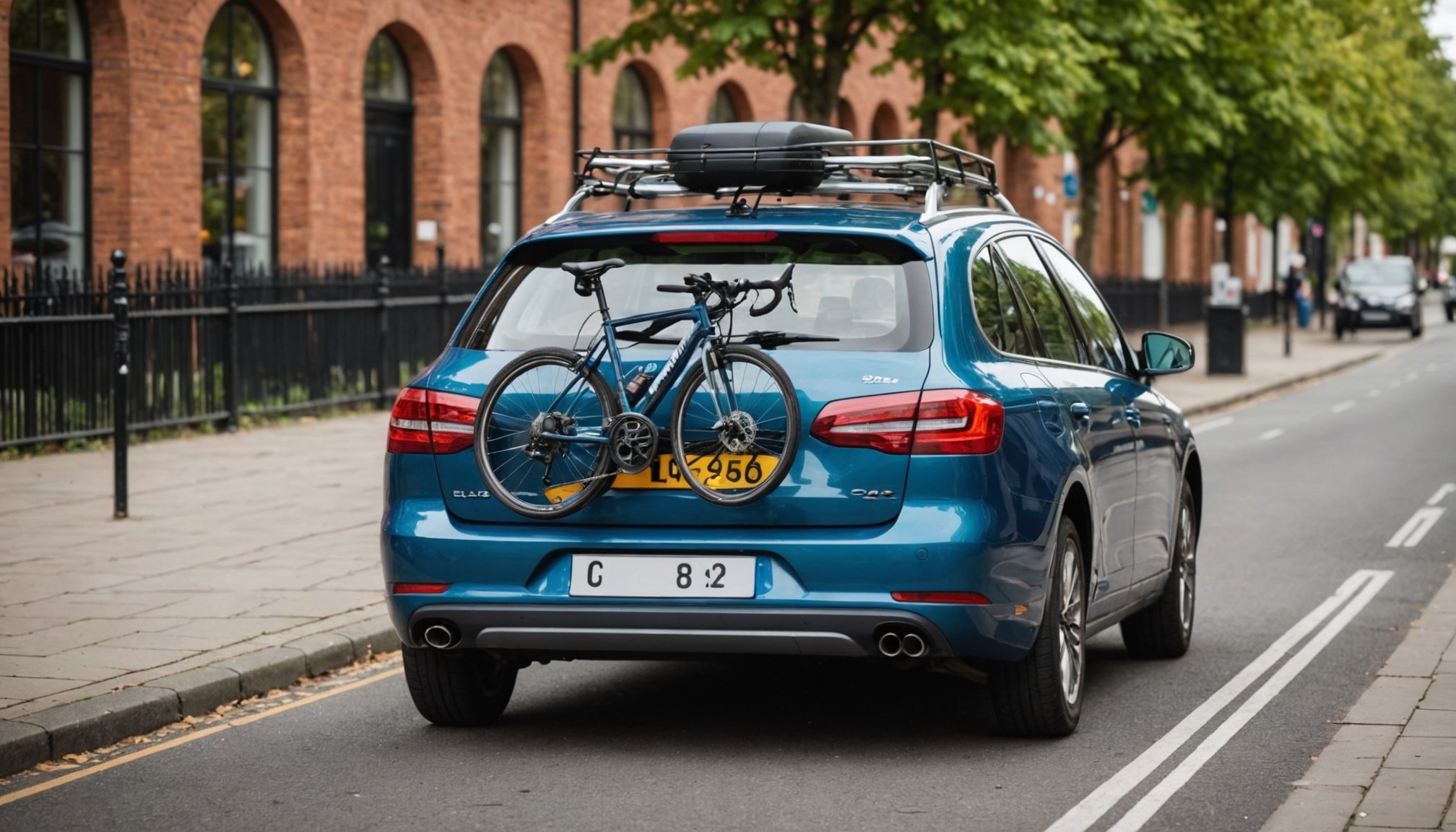Legal Requirements for Transporting Bicycles in the UK
Understanding the legal requirements for bicycle transport in the UK is crucial to ensure compliance and avoid potential fines. The UK has specific laws that pertain to the transportation of bicycles, particularly regarding vehicle compatibility and security measures.
Under UK regulations, vehicles must be equipped with suitable fixtures, such as roof racks or trailers, that are designed specifically for bicycle transportation. These fixtures must secure the bicycle firmly to prevent any movement that could pose a threat to road safety.
Also read : Complete handbook for setting up a compliant home ev charging station in the uk
Age restrictions often come into play, especially when younger individuals are involved in transporting bicycles. It is essential to adhere to the guidelines concerning the minimum driving age and ensure that appropriate liability coverage is in place. Younger drivers may face additional requirements such as having an experienced driver accompany them.
Compliance with these regulations not only helps in avoiding fines but is also critical for road safety. Authorities regularly enforce these rules, and non-compliance could lead to penalties or even legal action. Therefore, staying informed about UK bicycle transport laws is vital. Seeking professional advice or referring to official guidelines can provide clarity and help in abiding by the relevant legalities effectively.
Also to discover : Maximize your car”s efficiency: the ultimate uk guide to fuel savings through telematics
Transport Methods for Secure Bicycle Transportation
Transportation of bicycles in the UK requires compliance with specific bicycle transportation methods to ensure safety and legality. Let’s explore some of these methods.
Roof Racks
Roof racks are a popular choice for transporting bicycles. They come in different types like fork-mount racks, frame-mount racks, and wheel-mount racks. Advantages include freeing up vehicle cargo space and enabling transport of multiple bikes. However, they can increase wind resistance and impact fuel efficiency. For secure installation, follow the manufacturer’s guidelines and ensure all fittings are tightly secured to avoid any potential hazards.
Bike Mounts
Another option is bike mounts such as hitch and trunk mounts. Consider factors like vehicle compatibility, ease of installation, and bike security when choosing a mount. Hitch mounts offer strong support but require a towing hook, while trunk mounts are versatile but must be secured properly to prevent shifting during transit.
Interior Transport
Transporting bicycles inside a vehicle is feasible with proper loading techniques to avoid damage. Utilize padding to protect both the bicycle and vehicle. Legal considerations include ensuring the bike doesn’t obstruct driver visibility or control. Always adhere to UK traffic laws to guarantee a safe journey.
Safety Measures for Bicycle Transportation
Ensuring bicycle transport safety measures is essential to protect both vehicles and passengers. A firm understanding of these measures can prevent accidents and improve road experience.
To start, always review a safety checklist before setting out. Check for secure attachment of bicycles to the transport method. Ensure all locking mechanisms are engaged and free from obstructions like loose cables. Simple checks can avoid costly mishaps.
Equally important is enhancing visibility. Attach reflective materials or lights to bicycles. These can significantly increase night-time and low-visibility safety. Visibility aids not only alert other road users but also comply with legal standards.
Another key consideration involves signaling during travel. When using roof racks or mounts, bicycles can extend beyond the vehicle body. Ensure signaling devices, such as brake lights, are not obstructed. It’s also wise to check the transportation method doesn’t obscure the driver’s view of mirrors or road signals.
Before embarking on a journey, conducting safety inspections and implementing these visibility strategies can drastically minimize risks. For travellers, these practices can mean the difference between a secure trip and an unexpected incident.
Best Practices for Transportation
When considering the best practices for bicycle transport in the UK, several key strategies can improve efficiency and safety. One major tip is to ensure efficient loading and unloading. Practising these movements can save time and prevent bike or vehicle damage. Use guidelines to optimise the process and increase precision.
Common mistakes to avoid while transporting bicycles include not checking the attachment points of your roof rack or bike mount. Loose fittings can lead to accidents or fines. Similarly, failing to balance your vehicle’s load may endanger both the bikes and the vehicle.
Maintenance considerations before and after transportation are crucial. Check tyre pressure and brakes prior to loading to ensure the bicycle’s readiness for the journey. Post-transport, examine for any signs of wear or damage like scratched frames or bent wheels, and address repairs immediately.
For continuous improvement, consider creating a transport checklist. This step not only includes all necessary actions but also minimises the likelihood of overlooking vital steps. Following these best practices will facilitate a smoother bike transport experience and compliance with UK standards.
FAQs About Bicycle Transportation Regulations
The subject of bicycle transportation regulations in the UK often raises questions about legal requirements and enforcement measures. Here, we address some of the most common queries.
What are the primary legal requirements for transporting bicycles in the UK?
Vehicles must be equipped with fixtures such as roof racks or trailers specifically designed for bicycle transport. Securing bicycles firmly is essential to assure safety and comply with the regulations.
Are there penalties for failing to adhere to these requirements?
Yes, non-compliance with bicycle transport laws may lead to fines or legal actions. It’s essential to remain informed and abide by regulations to avoid these consequences.
Where can I find more detailed information about these regulations?
For those seeking further details, official government websites and advisory sources provide comprehensive guidance. Consulting transport authorities can also help clarify specific queries.
In summary, understanding bicycle transportation regulations is key to ensuring legal compliance and safety. These FAQs provide initial guidance, but always refer to authoritative resources for complete information. Seeking expert advice can help navigate any unique circumstances effectively.
Regional Specific Legislation and Considerations
Navigating the regional bicycle transport regulations in the UK can be daunting due to varying laws between regions. These regional differences demand careful attention to ensure full compliance and avoid legal complications. For instance, cities like London may impose additional requirements or restrictions compared to rural areas.
When researching local regulations, it’s crucial to use reliable sources such as government websites or local transport authorities. These platforms offer the most up-to-date information and guidance on compliance with the bicycle transport laws applicable in specific areas.
Moreover, understanding the outcomes of regional enforcement actions can provide valuable insight. Case studies from regions with stringent laws, such as certain London boroughs, highlight the consequences of failing to comply. Reviewing these scenarios helps individuals gauge potential risks and penalties.
Considering these regional nuances not only ensures legal compliance but also promotes safer bicycle transport practices. Engaging with local cycling communities or forums can also provide practical advice and firsthand experiences, further aiding in navigating these regional regulations effectively. This approach fosters a clearer understanding of obligations, ultimately facilitating a seamless and worry-free bicycle transportation process across the UK.











